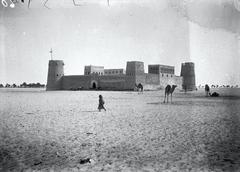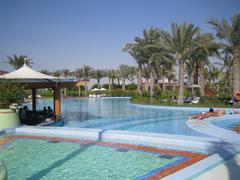
Comprehensive Guide to Qasr Al Hosn: Visiting Hours, Tickets, and Historical Significance
Date: 18/07/2024
Introduction to Qasr Al Hosn
Qasr Al Hosn, located in the heart of Abu Dhabi, stands as a monumental testament to the emirate’s rich history and cultural evolution. This iconic site, which has witnessed the transformation of Abu Dhabi from a modest fishing and pearling village to a bustling modern metropolis, offers visitors an immersive journey through time. The fort’s origins date back to the late 18th century, when the Bani Yas tribe, led by Sheikh Dhiyab bin Isa, constructed a coral and sea stone watchtower to guard the precious freshwater sources they discovered on Abu Dhabi island (Department of Culture and Tourism - Abu Dhabi). Over the centuries, Qasr Al Hosn has undergone numerous expansions and renovations, reflecting the changing needs and aspirations of the rulers and the people of Abu Dhabi. Today, it stands as a symbol of resilience, adaptation, and the rich cultural heritage of the UAE. Visitors to Qasr Al Hosn can explore its well-preserved structures, participate in cultural activities, and gain a deeper understanding of the emirate’s history and traditions (Qasr Al Hosn Official Site).
Table of Contents
- Introduction to Qasr Al Hosn
- Visitor Information
- Early Beginnings - The Watchtower (1761)
- The Growth of a Fort (1793-1818)
- The Reign of Sheikh Zayed bin Khalifa Al Nahyan (1855-1909)
- The Discovery of Oil and Modernization (1939-1966)
- From Fort to Museum (1966-Present)
- Cultural Significance - A Symbol of Identity and Heritage
- Travel Tips
- Nearby Attractions
- Special Events and Guided Tours
- FAQ
- Visitor Information
Exploring Qasr Al Hosn
Visitor Information
- Visiting Hours: Qasr Al Hosn is open from 9 AM to 7 PM daily, with extended hours on weekends.
- Tickets: Tickets are priced at AED 30 for adults and AED 15 for children. Discounts are available for groups and families. (Qasr Al Hosn Official Site)
- Accessibility: The site is wheelchair accessible and offers facilities for visitors with special needs.
Early Beginnings - The Watchtower (1761)
The story of Qasr Al Hosn begins in the late 18th century, around 1761. The Bani Yas tribe, led by Sheikh Dhiyab bin Isa, discovered freshwater sources on Abu Dhabi island. To protect their newfound resources and burgeoning community, they erected a coral and sea stone watchtower overlooking the vital waterways. This simple yet sturdy structure marked the genesis of Qasr Al Hosn, becoming the first permanent structure on the island and a beacon of defense in a nascent settlement (Department of Culture and Tourism - Abu Dhabi).
The Growth of a Fort (1793-1818)
As the 19th century dawned, the watchtower underwent a significant transformation. Under the leadership of Sheikh Shakhbut bin Dhiyab Al Nahyan, the ruler from 1793 to 1815, the watchtower was fortified and expanded into a small fort. This expansion provided enhanced protection, housed the ruling family, and served as the seat of governance. The fort, now known as Qasr Al Hosn, became a symbol of the ruling family’s authority and the town’s growing importance (Qasr Al Hosn Official Site).
The Reign of Sheikh Zayed bin Khalifa Al Nahyan (1855-1909)
The late 19th century witnessed a period of significant development and prosperity under Sheikh Zayed bin Khalifa Al Nahyan, fondly remembered as Zayed the First. His reign saw Qasr Al Hosn undergo further expansion and renovation. The fort’s fortifications were strengthened, and new structures, including residential quarters, administrative offices, and a majlis (meeting place), were added, reflecting the growing influence and wealth of Abu Dhabi (The National Archives).
The Discovery of Oil and Modernization (1939-1966)
The discovery of oil in 1958 ushered in an era of transformation for Abu Dhabi and Qasr Al Hosn. With newfound wealth, Sheikh Shakhbut bin Sultan Al Nahyan initiated modernization projects that significantly impacted the fort. New wings were constructed with modern materials, housing government offices and blending traditional and modern architecture (Etihad Modernity Grant).
From Fort to Museum (1966-Present)
In 1966, with Sheikh Zayed bin Sultan Al Nahyan at the helm of a newly formed nation, the United Arab Emirates, Qasr Al Hosn transitioned from a seat of power to a custodian of history. The fort underwent extensive restoration efforts, transforming it into a national monument and museum (The National).
Cultural Significance - A Symbol of Identity and Heritage
Beyond its physical presence, Qasr Al Hosn holds profound cultural significance for the people of Abu Dhabi:
- A symbol of resilience and adaptation: The fort’s evolution mirrors Abu Dhabi’s journey, reflecting the emirate’s ability to adapt and thrive amidst changing times.
- A repository of memories and traditions: Qasr Al Hosn preserves the memories and traditions of generations gone by.
- A place of gathering and celebration: The fort hosts numerous cultural events and festivals, reinforcing its role as a vital community space.
Travel Tips
- Best Time to Visit: The cooler months from November to March are ideal for visiting.
- Dress Code: Modest dress is recommended to respect local customs.
- Photography: Certain areas may have restrictions, so always ask for permission before taking photos.
Nearby Attractions
- The Corniche: A beautiful waterfront promenade perfect for leisurely walks and picnics.
- Louvre Abu Dhabi: A world-class museum showcasing art and artifacts from around the globe.
- Sheikh Zayed Grand Mosque: One of the largest mosques in the world, known for its stunning architecture.
Special Events and Guided Tours
- Guided Tours: Available daily, offering deep dives into the history and architecture of Qasr Al Hosn.
- Cultural Events: The fort hosts a variety of events, including traditional music performances, art exhibitions, and heritage festivals.
FAQ
Q: What are the Qasr Al Hosn visiting hours?
A: Qasr Al Hosn is open from 9 AM to 7 PM daily, with extended hours on weekends.
Q: How much are the Qasr Al Hosn tickets?
A: Tickets are priced at AED 30 for adults and AED 15 for children. Discounts are available for groups and families.
Q: Is Qasr Al Hosn accessible for visitors with disabilities?
A: Yes, the site is wheelchair accessible and offers facilities for visitors with special needs.
Call to Action
Explore the rich heritage of Abu Dhabi by visiting Qasr Al Hosn. Download the Audiala app for more travel tips, check out our other related posts, or follow us on social media for the latest updates.
Conclusion and Key Takeaways
Qasr Al Hosn is more than just a historical site; it is a living embodiment of Abu Dhabi’s rich heritage and cultural evolution. From its humble beginnings as a coral and sea stone watchtower to its current status as a national monument and museum, Qasr Al Hosn has played a pivotal role in the emirate’s history. The fort’s architecture, unique features, and cultural significance offer visitors a tangible link to the past, allowing them to immerse themselves in the rich tapestry of Emirati culture and heritage. Whether you’re exploring the ancient watchtower, participating in traditional craft workshops at the House of Artisans, or enjoying contemporary art at the Cultural Foundation, Qasr Al Hosn provides a multifaceted experience that will leave a lasting impression. As you plan your visit, remember to check the official website for the latest updates on events, workshops, and guided tours to make the most of your journey to this iconic historical site (Qasr Al Hosn Official Site).
References and Further Reading
- ‘Exploring Qasr Al Hosn - Visiting Hours, Tickets, and Historical Insights’ Department of Culture and Tourism - Abu Dhabi
- ‘Discover Qasr Al Hosn - Architectural Significance, Unique Features, and Visitor Information’ Etihad Modernity Grant
- ‘Visiting Qasr Al Hosn - Hours, Tickets, History, and Tips for Your Journey to Abu Dhabi’s Iconic Historical Site’ The National








